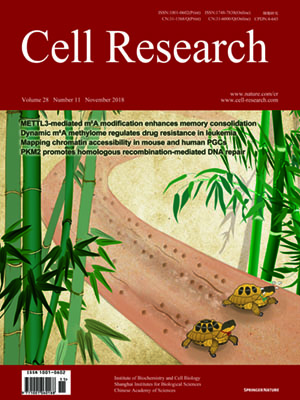
Volume 28, No 11, Nov 2018
ISSN: 1001-0602
EISSN: 1748-7838 2018
impact factor 17.848*
(Clarivate Analytics, 2019)
Volume 28 Issue 11, November 2018: 1077-1089
ORIGINAL ARTICLES
Accurate annotation of accessible chromatin in mouse and human primordial germ cells
Jingyi Li 1, Shijun Shen 1, Jiayu Chen 1, Wenqiang Liu 1, Xiaocui Li 1, Qianshu Zhu 1, Beiying Wang 1, Xiaolong Chen 1, Li Wu 1, Mingzhu Wang 1, Liang Gu 1, Hong Wang 1, Jiqing Yin 1, Cizhong Jiang 1,2 and Shaorong Gao 1
1 Clinical and Translational Research Center of Shanghai First Maternity and Infant Hospital, Shanghai Key Laboratory of Signaling and Disease Research, School of Life Sciences and Technology, Tongji University, Shanghai 200092, China and 2Institute of Translational Research, Tongji Hospital, Tongji University, Shanghai 200065, China
Correspondence: Correspondence: Cizhong Jiang (czjiang@tongji.edu.cn) or Shaorong Gao (gaoshaorong@tongji.edu.cn)These authors contributed equally: Jingyi Li, Shijun Shen, Jiayu Chen
Extensive and accurate chromatin remodeling is essential during primordial germ cell (PGC) development for the perpetuation of genetic information across generations. Here, we report that distal cis-regulatory elements (CREs) marked by DNase I-hypersensitive sites (DHSs) show temporally restricted activities during mouse and human PGC development. Using DHS maps as proxy, we accurately locate the genome-wide binding sites of pluripotency transcription factors in mouse PGCs. Unexpectedly, we found that mouse female meiotic recombination hotspots can be captured by DHSs, and for the first time, we identified 12,211 recombination hotspots in mouse female PGCs. In contrast to that of meiotic female PGCs, the chromatin of mitotic-arrested male PGCs is permissive through nuclear transcription factor Y (NFY) binding in the distal regulatory regions. Furthermore, we examined the evolutionary pressure on PGC CREs, and comparative genomic analysis revealed that mouse and human PGC CREs are evolutionarily conserved and show strong conservation across the vertebrate tree outside the mammals. Therefore, our results reveal unique, temporally accessible chromatin configurations during mouse and human PGC development.
https://doi.org/10.1038/s41422-018-0096-5
FULL TEXT | PDF
Browse 1129


